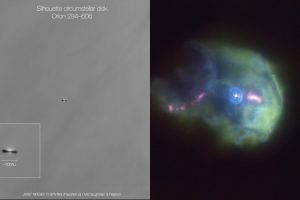Published the manifesto of the international task force for the study of environmental effects on the evolution of protoplanetary disks

Protoplanetary disks are structures of gas and dust that orbit around newly formed stars (referred to as both pre-main-sequence stars and protostars) during their very early evolutionary stages. In fact, they generally disperse in less than 10 million years.
Despite their short lifespan, protoplanetary disks play a crucial role. From the perspective of the star, for example, these disks mediate both the accretion of gas onto the star from the surrounding environment and the ejection of a significant amount of gas in the form of slow winds and fast, highly collimated jets. Furthermore, as their name suggests, the disks are the birthplace of planetary systems around young stars.
The evolution of these disks, their physical and chemical properties, and their dispersal timescales can also be influenced by the surrounding environment. This occurs through three phenomena, technically referred to as “feedback processes”.
In dense stellar environments, such as typical star-forming regions in their early evolutionary stages, gravitational interactions between nearby stars can have a significant impact on the morphology, structure, and physical properties of the disks. These interactions, known as “close encounters”, can induce intense transient accretion events, disperse part of the disk mass, or facilitate the aggregation of solids into planetary embryos.
Maassive stars emit enormous amounts of ultraviolet radiation. If a protoplanetary disk is irradiated by UV radiation from nearby massive stars (even up to a few light-years away), part of this radiation is absorbed by the gas and dust in the disk. This triggers a series of processes that alter its thermal structure and chemical properties, and in extreme cases, it can lead to the rapid dispersal of the disk itself. This process is known as “photoevaporation”. A similar effect can also be triggered by an intense flux of high-energy particles, such as cosmic rays.
As mentioned, the disk mediates the accretion of gas onto the central star. This accretion process typically ends within 3-5 million years. In some cases, more evolved systems are observed in which the disk captures pristine material from the surrounding environment, triggering a phenomenon of late accretion. It is believed that such material could have important consequences for the planetary formation process within the disk.
The study of environmental effects on the evolution and dispersal of protoplanetary disks is therefore a topic of utmost importance for understanding, for example, the most favorable environments and epochs for planetary system formation. To this end, an international team of about 50 astronomers has formed a task force to study these effects from all perspectives: through new high-spatial- and spectral-resolution observations of individual nearby protoplanetary disks, observations of populations of planetary disks in rich star-forming regions, typically at great distances from us, and through the development of physico-chemical models.
A true manifesto of this task force has recently been presented in the article: “The past, present, and future of observations of externally irradiated disks“, published in The Open Journal of Astrophysics. The paper outlines the state of the art in the study of environmental effects on protoplanetary disk evolution and strategies for future observations with next-generation instruments such as ALMA and the James Webb Space Telescope. Among the task force participants is the astronomer M. G. Guarcello from INAF – Osservatorio Astronomico di Palermo.
The attached figure (click here to view it in full) shows two images of protoplanetary disks. On the left, the object YSO 294-606 in the Orion Nebula, observed by JWST/NIRCam, does not show signs of environmental effects. In the right panel, however, the object YSO 244-440, observed by VLT/MUSE, is immersed in a nebula produced by gas “evaporated” from the disk due to photoevaporation induced by nearby massive stars.
Mario Giuseppe Guarcello
Follow MarioSpiegaCose on Instagram () , Facebook (), Youtube (), and X ()
Follow the Astronomical Observatory of Palermo on Facebok and on Instagram
Subscribe the Youtube channel of the Astronomical Observatory of Palermo
